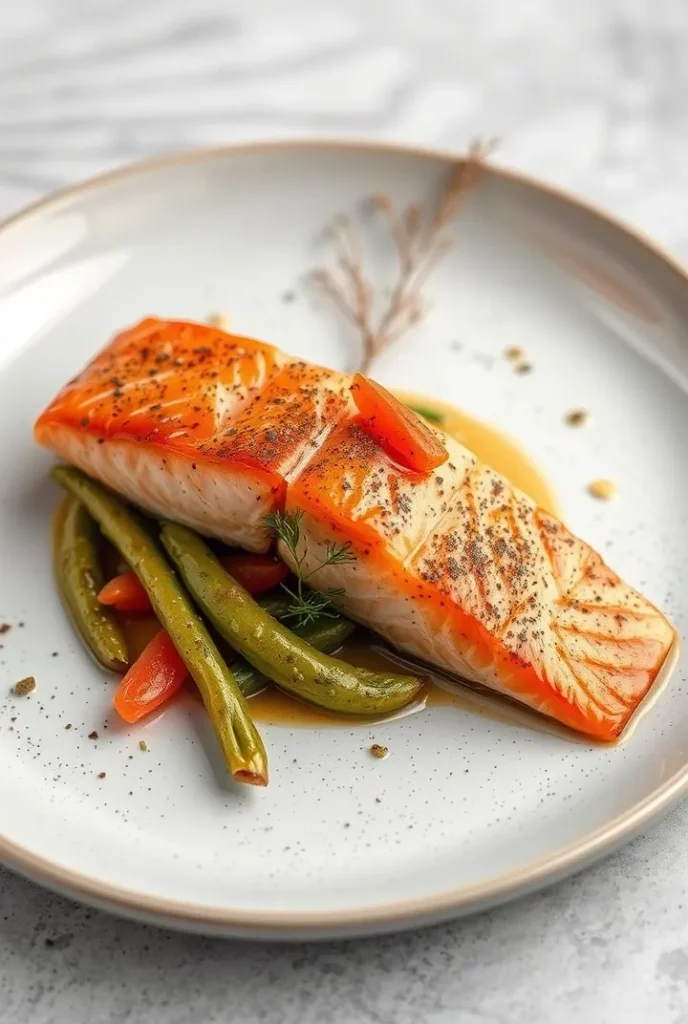Struggling with joint pain and fatigue after a long day? The secret might be hiding in anti inflammation foods for dinner that you walk past at the grocery store every week. These powerful ingredients can help reduce inflammation while satisfying your taste buds. Let’s explore the dinner options you’ve been missing out on.

1. Wild-Caught Salmon
Ingredients:
- 6 oz wild-caught salmon fillet
- 1 tablespoon olive oil
- Fresh lemon juice
- Garlic powder
- Black pepper
- Fresh dill
Preparation: Season your salmon with garlic powder and black pepper. Heat olive oil in a pan over medium heat. Cook the fillet skin-side down for 4-5 minutes, then flip and cook for another 3-4 minutes. Squeeze fresh lemon juice on top and garnish with dill before serving.
Tip: Check for doneness by pressing the salmon gently. It should flake easily but still look moist inside. Don’t overcook it, or you’ll lose those precious omega-3 fatty acids.
Benefits: Wild salmon packs omega-3 fatty acids that fight inflammation throughout your body. These healthy fats reduce joint pain and support heart health. Eating salmon twice weekly can lower inflammatory markers significantly. Your body absorbs these nutrients better from wild-caught fish than farm-raised varieties.
2. Turmeric-Spiced Chicken Breast
Ingredients:
- 2 chicken breasts
- 2 teaspoons turmeric powder
- 1 teaspoon ground cumin
- 1 tablespoon coconut oil
- Sea salt
- Fresh cilantro
Preparation: Mix turmeric, cumin, and salt in a small bowl. Rub this spice blend all over the chicken breasts. Heat coconut oil in a skillet over medium-high heat. Cook chicken for 6-7 minutes per side until golden brown and cooked through. Let rest for 5 minutes, then slice and top with fresh cilantro.
Tip: Add a pinch of black pepper to your turmeric. This increases the absorption of curcumin, turmeric’s active compound, by up to 2000%.
Benefits: Turmeric contains curcumin, one of nature’s strongest anti-inflammatory compounds. This spice reduces swelling and chronic pain as effectively as some medications. Regular consumption supports brain health and may prevent cognitive decline. The compound also aids digestion and promotes gut healing.
3. Leafy Green Salad with Kale and Spinach
Ingredients:
- 2 cups chopped kale
- 2 cups baby spinach
- 1/4 cup walnuts
- 2 tablespoons olive oil
- 1 tablespoon apple cider vinegar
- 1 teaspoon honey
- Cherry tomatoes
Preparation: Massage the kale with your hands for 2-3 minutes to soften it. This breaks down tough fibers and makes it easier to digest. Combine kale and spinach in a large bowl. Whisk together olive oil, vinegar, and honey for the dressing. Toss the greens with dressing and top with walnuts and halved cherry tomatoes.
Tip: Always massage raw kale before eating. This simple step transforms the tough leaves into tender, flavorful greens that won’t hurt your jaw.
Benefits: Dark leafy greens contain powerful antioxidants that neutralize free radicals in your body. These vegetables are loaded with vitamins K, A, and C that reduce inflammatory responses. The fiber content supports healthy digestion and feeds good gut bacteria. Eating greens daily can lower your risk of chronic diseases.
4. Baked Sweet Potato Wedges
Ingredients:
- 2 large sweet potatoes
- 2 tablespoons avocado oil
- 1 teaspoon paprika
- 1/2 teaspoon garlic powder
- Sea salt
- Fresh rosemary
Preparation: Preheat your oven to 425°F. Cut sweet potatoes into wedge shapes. Toss wedges with avocado oil, paprika, garlic powder, and salt. Spread them on a baking sheet in a single layer. Bake for 25-30 minutes, flipping halfway through. Sprinkle with fresh rosemary before serving.
Tip: Don’t crowd the baking sheet. Give each wedge space so they get crispy instead of steaming. You want golden edges and tender insides.
Benefits: Sweet potatoes are rich in beta-carotene, which your body converts to vitamin A. This nutrient reduces inflammation and supports immune function. The high fiber content stabilizes blood sugar levels and prevents inflammatory spikes. These root vegetables also contain anthocyanins that protect against cellular damage.
5. Garlic and Ginger Stir-Fry
Ingredients:
- 4 cloves garlic, minced
- 2 tablespoons fresh ginger, grated
- 2 cups mixed vegetables (broccoli, bell peppers, snap peas)
- 1 tablespoon sesame oil
- 2 tablespoons low-sodium soy sauce
- Sesame seeds
Preparation: Heat sesame oil in a wok or large skillet over high heat. Add minced garlic and grated ginger, stirring constantly for 30 seconds until fragrant. Toss in your vegetables and stir-fry for 4-5 minutes. Add soy sauce and cook for another minute. Sprinkle with sesame seeds before serving.
Tip: Prep all your ingredients before you start cooking. Stir-frying happens fast, and you won’t have time to chop once the pan gets hot.
Benefits: Garlic contains sulfur compounds that reduce inflammatory cytokines in your body. Ginger has gingerol, a powerful anti-inflammatory agent that relieves muscle pain and soreness. These two ingredients work together to boost your immune system. They also support cardiovascular health and improve circulation.
6. Grilled Mackerel with Herbs
Ingredients:
- 2 mackerel fillets
- 2 tablespoons olive oil
- Fresh thyme and oregano
- Lemon zest
- Sea salt and pepper
Preparation: Brush mackerel fillets with olive oil on both sides. Season with salt, pepper, and lemon zest. Place fresh thyme and oregano sprigs on top. Grill over medium-high heat for 3-4 minutes per side. The skin should be crispy and the flesh should flake easily.
Tip: Oil your grill grates well before cooking fish. This prevents the delicate skin from sticking and tearing when you flip it.
Benefits: Mackerel contains even more omega-3s than salmon. These essential fatty acids reduce joint stiffness and morning pain. The fish also provides vitamin D, which plays a crucial role in regulating inflammation. Eating oily fish regularly can decrease your risk of autoimmune conditions.
7. Steamed Broccoli with Lemon
Ingredients:
- 3 cups broccoli florets
- 1 tablespoon extra virgin olive oil
- Juice of 1 lemon
- 2 cloves garlic, minced
- Red pepper flakes
Preparation: Fill a pot with 2 inches of water and bring to a boil. Place broccoli in a steamer basket and steam for 5-7 minutes until bright green and tender-crisp. Transfer to a serving bowl. Toss with olive oil, lemon juice, minced garlic, and a pinch of red pepper flakes.
Tip: Don’t over-steam your broccoli. It should still have a slight crunch. Mushy broccoli loses nutrients and tastes bitter.
Benefits: Broccoli contains sulforaphane, a compound that blocks inflammatory enzymes. This cruciferous vegetable supports your body’s detoxification processes. The high vitamin C content boosts collagen production and tissue repair. Regular consumption may reduce your risk of certain cancers.
8. Black Bean and Vegetable Bowl
Ingredients:
- 1 can black beans, drained and rinsed
- 1 cup cooked quinoa
- 1 avocado, sliced
- 1 cup cherry tomatoes, halved
- Fresh cilantro
- Lime juice
- Cumin
Preparation: Warm black beans in a small pot with a pinch of cumin. Prepare quinoa according to package directions. Build your bowl with quinoa as the base, then add black beans, tomatoes, and avocado slices. Squeeze fresh lime juice over everything and top with cilantro.
Tip: Always rinse canned beans thoroughly. This removes excess sodium and the starchy liquid that can cause digestive discomfort.
Benefits: Black beans provide fiber and plant-based protein that stabilize blood sugar. They contain anthocyanins that fight oxidative stress and inflammation. The resistant starch in beans feeds beneficial gut bacteria. A healthy gut microbiome reduces systemic inflammation throughout your body.
9. Beets Roasted with Olive Oil
Ingredients:
- 4 medium beets, peeled and cubed
- 2 tablespoons olive oil
- 1 tablespoon balsamic vinegar
- Fresh thyme
- Sea salt
Preparation: Preheat your oven to 400°F. Toss cubed beets with olive oil, salt, and fresh thyme leaves. Spread on a baking sheet lined with parchment paper. Roast for 35-40 minutes until tender and caramelized. Drizzle with balsamic vinegar before serving.
Tip: Wear gloves when handling raw beets. They’ll stain your hands bright red, and the color takes days to fade completely.
Benefits: Beets contain betalains, unique pigments with powerful anti-inflammatory properties. These root vegetables improve blood flow and lower blood pressure. The nitrates in beets enhance athletic performance and reduce exercise-induced inflammation. They also support liver detoxification.
10. Walnut-Crusted White Fish
Ingredients:
- 2 white fish fillets (cod or halibut)
- 1/2 cup crushed walnuts
- 1 tablespoon Dijon mustard
- 1 tablespoon olive oil
- Fresh parsley
Preparation: Preheat your oven to 375°F. Brush fish fillets with Dijon mustard. Press crushed walnuts onto the top of each fillet. Drizzle with olive oil. Bake for 15-18 minutes until fish flakes easily and the walnut crust is golden. Garnish with fresh parsley.
Tip: Pat your fish completely dry before adding the mustard. Moisture prevents the walnut crust from sticking properly.
Benefits: Walnuts are the only nuts with significant amounts of omega-3 fatty acids. They reduce markers of inflammation and support brain health. The combination of healthy fats and lean protein keeps you satisfied. Regular walnut consumption may improve gut bacteria diversity.
11. Tomato and Basil Soup
Ingredients:
- 6 large ripe tomatoes, chopped
- 1 onion, diced
- 3 cloves garlic, minced
- 2 cups vegetable broth
- Fresh basil leaves
- 2 tablespoons olive oil
- Sea salt and pepper
Preparation: Heat olive oil in a large pot over medium heat. Sauté onion and garlic until soft, about 5 minutes. Add chopped tomatoes and cook for 10 minutes until they break down. Pour in vegetable broth and simmer for 15 minutes. Blend until smooth using an immersion blender. Stir in fresh basil and season with salt and pepper.
Tip: Use the ripest tomatoes you can find. They have more lycopene and natural sweetness, which means you won’t need added sugar.
Benefits: Tomatoes are loaded with lycopene, a carotenoid that reduces inflammatory markers. Cooking tomatoes actually increases lycopene availability. The combination of tomatoes and olive oil enhances nutrient absorption. This soup provides vitamin C and potassium that support overall health.
12. Grilled Asparagus with Garlic
Ingredients:
- 1 pound asparagus spears
- 2 tablespoons olive oil
- 3 cloves garlic, minced
- Lemon zest
- Parmesan cheese (optional)
- Sea salt
Preparation: Trim the woody ends off asparagus spears. Toss with olive oil, minced garlic, and salt. Heat your grill to medium-high. Grill asparagus for 5-7 minutes, turning occasionally until tender and lightly charred. Finish with lemon zest and a sprinkle of Parmesan if desired.
Tip: Look for asparagus spears that are similar in thickness. This ensures they all cook at the same rate and finish together.
Benefits: Asparagus contains glutathione, a master antioxidant that fights inflammation. This vegetable acts as a natural diuretic and helps reduce bloating. The prebiotic fiber feeds healthy gut bacteria. Asparagus also provides folate, which supports cellular repair.
13. Chia Seed Pudding with Berries
Ingredients:
- 3 tablespoons chia seeds
- 1 cup unsweetened almond milk
- 1/2 teaspoon vanilla extract
- 1 cup mixed berries (blueberries, strawberries, raspberries)
- 1 teaspoon honey (optional)
Preparation: Mix chia seeds, almond milk, and vanilla extract in a jar or bowl. Stir well to prevent clumping. Cover and refrigerate for at least 4 hours or overnight. The mixture will thicken into a pudding consistency. Top with fresh berries before serving.
Tip: Stir your chia pudding after the first 30 minutes in the fridge. This prevents the seeds from settling at the bottom and clumping together.
Benefits: Chia seeds are packed with omega-3 fatty acids and fiber. They help stabilize blood sugar and reduce inflammation. The antioxidants in berries work synergistically with chia’s nutrients. This combination supports heart health and cognitive function.
14. Lentil and Vegetable Stew
Ingredients:
- 1 cup dried red lentils
- 1 carrot, diced
- 1 celery stalk, diced
- 1 onion, chopped
- 2 cups vegetable broth
- 1 teaspoon cumin
- 1/2 teaspoon turmeric
- 2 tablespoons olive oil
Preparation: Heat olive oil in a large pot over medium heat. Sauté onion, carrot, and celery for 5 minutes. Add cumin and turmeric, stirring for 30 seconds. Pour in lentils and vegetable broth. Bring to a boil, then reduce heat and simmer for 20-25 minutes until lentils are tender.
Tip: Red lentils cook much faster than green or brown varieties. They also break down into a creamy texture perfect for stews.
Benefits: Lentils provide plant-based protein and soluble fiber that reduce inflammation. They’re rich in polyphenols that act as antioxidants. The combination of spices enhances the anti-inflammatory effects. Lentils support stable energy levels without blood sugar spikes.
15. Brussels Sprouts with Balsamic Glaze
Ingredients:
- 1 pound Brussels sprouts, halved
- 2 tablespoons olive oil
- 3 tablespoons balsamic vinegar
- 1 tablespoon honey
- Sea salt and pepper
Preparation: Preheat your oven to 400°F. Toss Brussels sprouts with olive oil, salt, and pepper. Spread on a baking sheet cut-side down. Roast for 20-25 minutes until caramelized. While they roast, simmer balsamic vinegar and honey in a small saucepan until reduced by half. Drizzle glaze over roasted Brussels sprouts.
Tip: Don’t skip the cut-side down placement. This creates delicious caramelized edges that convert even Brussels sprouts haters.
Benefits: Brussels sprouts contain kaempferol, a compound that reduces chronic inflammation. These mini cabbages support detoxification pathways in your liver. The high vitamin K content promotes bone health. They also provide sulforaphane, which may help prevent cancer development.
16. Ginger Green Tea Poached Chicken
Ingredients:
- 2 chicken breasts
- 2 cups brewed green tea
- 2-inch piece fresh ginger, sliced
- 2 cloves garlic
- 1 tablespoon low-sodium soy sauce
- Green onions
Preparation: Combine green tea, ginger slices, garlic, and soy sauce in a large skillet. Bring to a gentle simmer. Add chicken breasts and cover. Poach for 15-18 minutes until cooked through. Remove chicken and let rest for 5 minutes. Slice and serve with chopped green onions.
Tip: Keep the poaching liquid at a bare simmer, not a rolling boil. This keeps the chicken incredibly tender and prevents it from drying out.
Benefits: Green tea contains EGCG, a powerful antioxidant that fights inflammation at the cellular level. The combination with ginger creates a synergistic anti-inflammatory effect. This cooking method keeps chicken moist without added fats. The dish supports metabolism and immune function.
17. Dark Chocolate and Almond Bark
Ingredients:
- 4 ounces dark chocolate (70% cacao or higher)
- 1/2 cup raw almonds, roughly chopped
- Sea salt flakes
- 1 teaspoon coconut oil
Preparation: Melt dark chocolate with coconut oil in a double boiler or microwave in 30-second intervals. Stir until smooth. Pour onto a parchment-lined baking sheet. Sprinkle chopped almonds on top and press gently. Add a pinch of sea salt flakes. Refrigerate for 30 minutes until firm, then break into pieces.
Tip: Choose chocolate with at least 70% cacao content. Higher cacao means more flavonoids and less sugar for maximum anti-inflammatory benefits.
Benefits: Dark chocolate contains flavonoids that reduce inflammation and improve blood flow. The combination with almonds provides healthy fats and vitamin E. This treat satisfies sweet cravings without causing inflammatory sugar spikes. Moderate consumption supports heart health and mood regulation.

Lifebing is driven by an unrelenting passion for promoting health and well-being, our team is wholly committed to curating exceptional content and immersive experiences.
